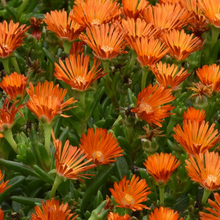Delosperma 'Hot Orange' is a low growing drought tolerant perennial succulent that produces vibrant orange flowers throughout the summer. Its fleshy green foliage forms dense mats making it ideal for rock gardens, sunny borders, and container edges. This cultivar thrives in full sun and well drained soil, adding long lasting color and texture to dry sunny landscapes.
Height & Spread: 4 - 6 in x 12 - 18 in
Bloom Time: Late spring through fall
Light Requirements: Full sun
Soil Preference: Well drained, sandy or rocky soil
Watering Needs: Low; drought tolerant once established
Deer Resistance: Generally avoided due to succulent foliage
Native Status
Delosperma 'Hot Orange' is derived from South African ice plant species. While not native to North America, it performs exceptionally in hot, sunny, and dry conditions.
WILDLIFE & INSECTS
Bees
- Honeybees, bumblebees, and native solitary bees flock to its bright orange flowers supporting pollination in dry landscapes.
Butterflies
- Painted Ladies and Fiery Skippers are attracted to nectar rich blooms for continuous summer color.
Predatory Insects
- Encourages lady beetles and lacewings, which help control aphids and other small pests in sunny garden areas.
Spacing & Landscape Use
Spacing Recommendations:
- Space 12 - 18 in apart to allow full matting and healthy air circulation.
Landscape Placement:
- Perfect for rock gardens, sunny borders, container edges, and dry slopes where color and drought tolerance are desired.
Companion Plants
- Lavandula angustifolia (English Lavender) - Silver foliage and fragrant purple flowers complement the orange flowers of Delosperma.
- Thymus serpyllum (Creeping Thyme) - Low growing matting herb adds texture and aromatic interest in sunny garden areas.
- Echinacea purpurea (Purple Coneflower) - Upright blooms attract pollinators and provide seasonal interest alongside Delosperma.
- Agave parryi (Parry's Agave) - Architectural succulent adds structure and a bold contrast to low growing mats.
- Sedum (Autumn Joy) - Succulent foliage and pink flower heads contrast well with vibrant orange blooms.



